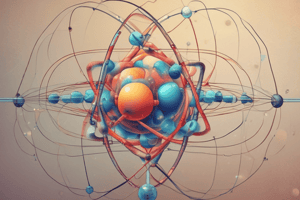Podcast
Questions and Answers
What is the charge of an electron in an atom?
What is the charge of an electron in an atom?
- +2
- +1
- 0
- -1 (correct)
Which particle is found in the nucleus of an atom?
Which particle is found in the nucleus of an atom?
- Both protons and neutrons (correct)
- Neutron
- Proton
- Electron
What is the unit used to measure the mass of atoms and subatomic particles?
What is the unit used to measure the mass of atoms and subatomic particles?
- Electron volt (eV)
- Atomic mass unit (amu) or Dalton (correct)
- Kilogram (kg)
- Gram (g)
Which property of atoms can be used to determine their position in the periodic table?
Which property of atoms can be used to determine their position in the periodic table?
What is the purpose of the Graph-To-Structure (G2S) machine learning model?
What is the purpose of the Graph-To-Structure (G2S) machine learning model?
How can scientists use the predictable half-life of decaying isotopes?
How can scientists use the predictable half-life of decaying isotopes?
What is the primary role of the electron cloud in an atom?
What is the primary role of the electron cloud in an atom?
Which of the following is the most accurate description of how the number of neutrons in an atom's nucleus affects its properties?
Which of the following is the most accurate description of how the number of neutrons in an atom's nucleus affects its properties?
Assume an atom has 3 protons and 4 neutrons in its nucleus. What is the atomic number and mass number of this atom?
Assume an atom has 3 protons and 4 neutrons in its nucleus. What is the atomic number and mass number of this atom?
How do chemists use predictive techniques to understand the behavior of atoms and molecules?
How do chemists use predictive techniques to understand the behavior of atoms and molecules?
What is the primary function of the nucleus in an atom?
What is the primary function of the nucleus in an atom?
How do the properties of atoms, such as atomic number and mass number, influence the behavior of elements in chemical reactions?
How do the properties of atoms, such as atomic number and mass number, influence the behavior of elements in chemical reactions?
What is the significance of the principal quantum number (n) in determining the energy levels or shells where electrons can occupy?
What is the significance of the principal quantum number (n) in determining the energy levels or shells where electrons can occupy?
Which of the following is a key advantage of the Graph-To-Structure (G2S) machine learning model for predicting atomic structures?
Which of the following is a key advantage of the Graph-To-Structure (G2S) machine learning model for predicting atomic structures?
How do traditional methods for predicting atomic structures, such as force fields or ab initio methods, differ from the approach used by the Graph-To-Structure (G2S) machine learning model?
How do traditional methods for predicting atomic structures, such as force fields or ab initio methods, differ from the approach used by the Graph-To-Structure (G2S) machine learning model?
How does the performance of the Graph-To-Structure (G2S) machine learning model improve as the size of the training dataset increases?
How does the performance of the Graph-To-Structure (G2S) machine learning model improve as the size of the training dataset increases?
What is the primary limitation of traditional energy optimization techniques, such as force fields or ab initio methods, that the Graph-To-Structure (G2S) machine learning model aims to address?
What is the primary limitation of traditional energy optimization techniques, such as force fields or ab initio methods, that the Graph-To-Structure (G2S) machine learning model aims to address?
How does the Graph-To-Structure (G2S) machine learning model leverage the implicit correlations within the training set of relaxed structures to generalize across compound space?
How does the Graph-To-Structure (G2S) machine learning model leverage the implicit correlations within the training set of relaxed structures to generalize across compound space?
Study Notes
Atomic Structure and Predictability in Chemistry
Understanding the Basics of Atomic Structure
Atoms are the fundamental building blocks of matter and are made up of three main particles: protons, neutrons, and electrons. These particles are responsible for the mass and charge of atoms. The nucleus, which contains both protons and neutrons, is located in the center of the atom. Electrons, which have a negative charge (-1), are found in the outer region of the atom and orbit around the nucleus.
Protons and neutrons have approximately the same mass, about 1.67 × 10^-24 grams, which scientists define as one atomic mass unit (amu) or one Dalton. Each electron also has a negative charge (-1) equal to the positive charge of a proton (+1). Neutrons are uncharged particles found within the nucleus.
Predictability in Atomic Structure
Understanding atomic structure allows scientists to predict various properties of elements. For example, the electronic configuration of an element can be used to determine its position in the periodic table. Additionally, the predictable half-life of different decaying isotopes allows scientists to date materials based on their isotopic composition.
Machine Learning in Atomic Structure Prediction
Recent advancements in machine learning have led to the development of models like Graph-To-Structure (G2S), which can effectively predict 3D atomic structures. G2S uses a data-driven approach to learn from existing training sets of relaxed structures and infers interatomic distances, enabling direct coordinate reconstruction without relying on energy optimization tasks. This revolutionary method has shown great potential for predicting structures of various systems, including organic molecules, transition states, and crystalline solids.
Studying That Suits You
Use AI to generate personalized quizzes and flashcards to suit your learning preferences.
Description
Test your knowledge on atomic structure and predictability in chemistry. Learn about the basic components of atoms, the role of protons, neutrons, and electrons, and how understanding atomic structure helps in predicting various properties of elements. Explore the advancements in machine learning for predicting 3D atomic structures using models like Graph-To-Structure (G2S).



